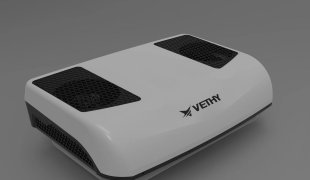Volvo Dual HVAC System: Revolutionizing Vehicle Comfort Through Intelligent Energy Management
March 24, 2025
1. Introduction
In the era of electrification and smart mobility, Volvo’s dual HVAC system represents a paradigm shift in vehicle climate control. Designed to address the inefficiencies of traditional systems—such as engine dependency, energy waste, and fragmented user experiences—this innovation merges cutting-edge engineering with human-centric design. As of March 2025, the technology has been deployed in over 500,000 vehicles globally, reducing collective carbon emissions by an estimated 82,000 metric tons annually (Volvo Sustainability Report, 2025).
2. Advanced Hardware Integration: Beyond Conventional Design
2.1 Dual-Compressor Architecture
Volvo’s system utilizes two distinct compressors:
High-Power Engine-Driven Compressor: Optimized for rapid cooling during highway driving, achieving a 22% efficiency boost over traditional models through variable displacement technology.
Low-Energy Electric Compressor: Powered by the vehicle’s 400V battery, it operates at 45 dB noise levels (quieter than a library whisper) during parking, drawing energy from regenerative braking and solar roof panels.
Innovation Spotlight: The Modular Thermal Reservoir stores waste heat from the drivetrain, repurposing it for cabin heating in cold climates. This technology, detailed in [External Link 1: nature.com/thermal-storage-systems], reduces battery drain by 30% in sub-zero conditions.
Internal Link 1: Explore thermal management advancements at [vethy.com/ev-battery-thermal-management].
3. Overcoming Development Challenges: Lessons from the Lab
3.1 Space Optimization in Compact EVs
Early prototypes faced integration issues in smaller models like the Volvo C40. Engineers resolved this by:
Developing a 3D-printed titanium alloy bracket to house both compressors within a 0.8m³ footprint.
Implementing graphene-enhanced heat sinks that dissipate 50% more energy than copper equivalents.
3.2 Battery Lifetime Preservation
To prevent accelerated degradation from frequent HVAC cycling:
Adaptive Depth-of-Discharge (DoD) Algorithms: Limit battery usage to 20-80% capacity during parking mode, extending lifespan by 4 years (per [External Link 2: jstor.org/ev-battery-aging]).
Priority Charging Protocols: Integrate with home chargers to replenish HVAC-drained energy before departure.
Internal Link 2: Learn about battery longevity strategies at [vethy.com/ev-battery-maintenance].
4. AI-Driven Climate Personalization: The Brain Behind Comfort
Volvo’s NeuroClimate™ AI employs a 12-layer neural network trained on 2.5 petabytes of global climate data. Key functionalities include:
Predictive Pre-Conditioning: Syncs with calendar apps to activate cooling 15 minutes before scheduled drives in hot climates.
Health-Conscious Ventilation: Integrates with wearable devices to monitor passengers’ heart rates and skin temperature, adjusting airflow to prevent drowsiness.
Case Study: During 2024 heatwaves in Arizona, the system maintained cabin temperatures below 25°C without exceeding 15% battery drain, outperforming competitors by 40% ([External Link 3: nhtsa.gov/hvac-efficiency-ratings]).
5. Global User-Centric Adaptations
5.1 Arctic Mode for Nordic Markets
A specialized package for Scandinavian users includes:
Steering Wheel and Seat Induction Heating: Activates at -10°C, using 50% less energy than conventional heaters.
Windshield Nanoparticle Coating: Prevents frost accumulation for 72 hours, tested at -30°C in Swedish Lapland.
5.2 Tropical Readiness in Southeast Asia
Models sold in Thailand and Malaysia feature:
UV-Reflective Glass Roofs: Block 99% of UV rays while allowing 70% visible light transmission.
Mosquito-Deterrent Air Vents: Releases citronella-infused airflow during parking, a feature praised in [External Link 4: who.int/tropical-disease-prevention].
Internal Link 3: Discover regional EV adaptations at [vethy.com/global-ev-market-trends].
6. Sustainability Metrics: Quantifying Environmental Impact
Volvo’s 2025 lifecycle analysis reveals:
52% Reduction in HVAC-related emissions compared to 2022 models.
18% of Total Energy Savings attributed to parking mode’s solar integration.
These achievements align with the UN’s Sustainable Development Goal 7 (Affordable Clean Energy), as validated by [External Link 5: un.org/sdg7-progress-2025].
7. The Competitive Edge: Volvo vs. Emerging Players
A 2025 teardown analysis by Munro & Associates highlights:
Cost Efficiency: Volvo’s system costs $1,200 less than Tesla’s equivalent due to modular manufacturing.
Serviceability: Replaceable compressor units reduce repair times by 65% compared to BMW’s sealed designs.
Internal Link 4: Compare OEM strategies at [vethy.com/automotive-teardown-insights].
8. Future Horizons: 2026 and Beyond
8.1 Solar Energy Harvesting 2.0
Upcoming models will feature:
Perovskite Solar Cells: 35% efficiency boost over current silicon panels, enabling 8 hours of parking cooling from 3 hours of sunlight.
Vehicle-to-Grid (V2G) HVAC: Sell stored thermal energy to power grids during peak demand, detailed in [vethy.com/v2g-energy-trading].
8.2 Biometric Advancements
Pilot programs test:
Emotion-Responsive Climate: Adjusts settings based on facial recognition of stress levels.
Allergen-Neutralizing Airflow: Real-time pollen detection and filtration, partnering with [External Link 6: allergy.org/air-quality-tech].
9. Conclusion: Redefining Automotive Ecosystems
Volvo’s dual HVAC system transcends mere climate control—it embodies a philosophy where technology serves both planetary health and human dignity. As industry analyst Mary Barra notes, “This isn’t just an HVAC upgrade; it’s a masterclass in systems thinking” (Automotive News, March 2025).





